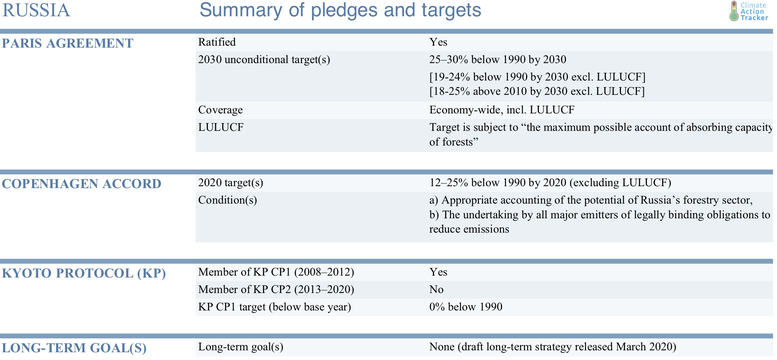Pledges And Targets
Summary table

Paris Agreement targets
NDC update: In November 2020, the Russian Federation submitted an updated NDC. Our analysis of its new target is here.
The Russian Federation submitted its 2030 Intended Nationally Determined Contribution (INDC), proposing to reduce emissions by 25% to 30% below 1990 levels by 2030 (UNFCCC, 2015). The Russian government officially signed the Paris Agreement (PA) on 22 April 2016, and formally accepted the agreement in October 2019, three and a half years later (United Nations, 2019).
Our best estimate of the target emission levels that Russia’s NDC entails is 2.4 GtCO2e to 2.6 GtCO2e in 2030 (19–24% below 1990 levels, excluding LULUCF). The Russian NDC contains the statement, however, that the 2030 target “is subject to the maximum possible accounting of the absorbing capacity of forests” (UNFCCC, 2015). While Russia’s target has not changed, an update to the projected LULUCF emissions in 2030 in Russia’s Fourth Biennial Report (2019) results in a slightly lower emissions level when considering total emissions excluding LULUCF (-66 MtCO2e).
If Russia formally adopts its proposed updated 2030 target of a 33% reduction below 1990 levels, this would amount to a 2030 emissions level of 2.3 GtCO2e (27% below 1990 levels, excluding LULUCF). Given the latest emissions projections under current policies provided by the Russian Government show 2030 emissions at 2.3 GtCO2e (excluding LULUCF), this does not represent a real cut to emissions. The Climate Action Tracker has undertaken a detailed analysis of Russia’s proposed NDC update and a comparison to the current target, which can be found here.
2020 Pledges
In the Copenhagen Accord from 2009, the Russian Federation pledged to limit emissions by 15–25% below 1990 levels by 2020 (Russian Federation Government, 2010). Due to lack of clarity regarding the inclusion of the LULUCF sector in the 2020 target, in our assessment we show estimates of the resulting 2020 target emissions levels for both, excluding, and including LULUCF in the base year. Under these scenarios, the 2020 target emissions level would be 2.4 to 2.7 GtCO2e, which is 11–25% above 2017 non-LULUCF emissions.
In September 2013, the Russian Federation adopted Decree No. 752 On Reducing Greenhouse Gas Emissions, which set a target of reducing emissions 25% below 1990 levels by 2020. This target was reaffirmed in Decree No. 504-p in April 2014 (Russian Federation, 2014a) and is in line with the lower end of the Copenhagen Pledge’s range, which we have rated as “inadequate”.
Long-term goal
In previous assessments, the CAT had included a long-term target for Russia of cutting GHG emissions by at least 50% below 1990 levels by 2050, based on the announcement made by the former Russian president Medvedev at the L’Aquila G8 Summit in 2009 (Yale Center for Environmental Law, 2011).
In March 2020, Russia released its draft long-term climate strategy (Russian Federation, 2020a), which outlined two sets of emissions projections to 2050; a “baseline” scenario, which results in 26% higher emissions than 2017 levels (36% below 1990 levels), and an “intensive” scenario, which results in an emissions level 3% higher than 2017 levels (48% below 1990 levels). The strategy recommends adoption of the less ambitious “baseline” scenario, which is vastly inadequate given the IPCC’s finding that global CO2 emissions in 2050 must reach net-zero in order to limit warming to 1.5°C (IPCC, 2018).
As this strategy has yet to be formally adopted, the CAT has not included the emissions reduction scenarios contained within it into this country assessment. If it is formalised in the future, it will subsequently be incorporated into this analysis.
Further analysis
Latest publications
Stay informed
Subscribe to our newsletter




